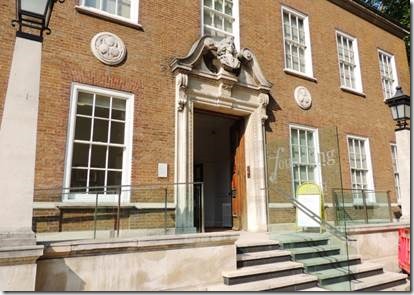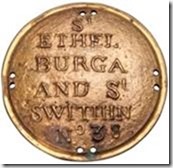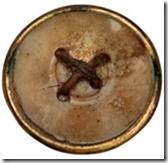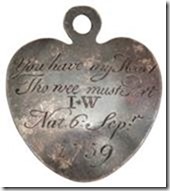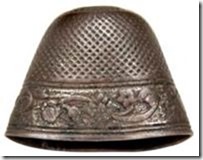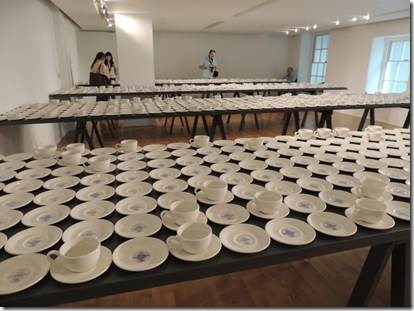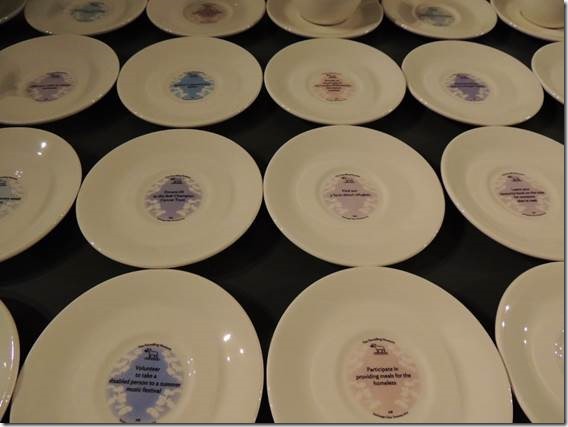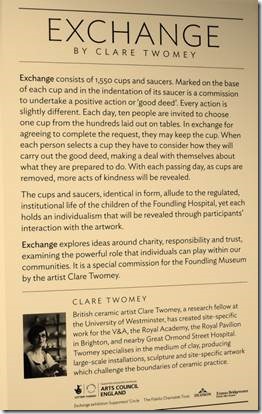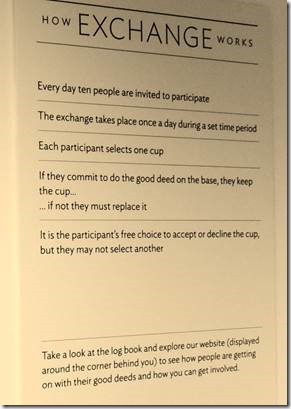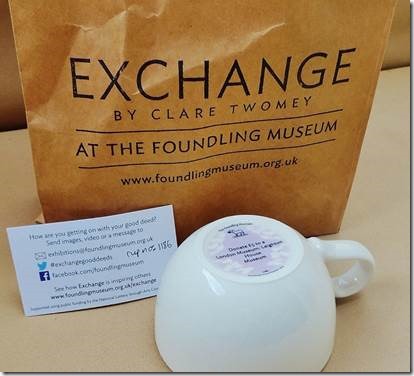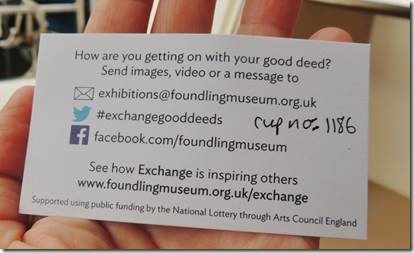Cheers,
We’re off to Charring Cross Road today and probably take the # 15 bus after all our walking yesterday! Every 3rd bus is a tour type with outside seating or so we were told by a really interesting fellow who’d hitch-hiked from London to Turkey 30 years ago with a trucker delivering pipe to European countries. Funny enough his daughter and partner are now doing the same thing as the fellow and the driver had kept in touch all these years. The daughter and her partner sleep in the cab and the driver sleeps in a bag on the ground. We found this out while resting between bridges yesterday afternoon.
Ru
Foundling Museum http://www.foundlingmuseum.org.uk/ plan to spend enough time to listen to the recordings of children who lived there.
The Foundling Museum
http://www.gresham.ac.uk/ is a video lecture about the Foundling Museum
Foundling Museum
“A seaman, a composer and a painter, and the moving story of the charity they started 270 years ago. It is a recipe of art and care, which still looks after kids today. Coram, Handel, Hogarth, what’s not to love?” Grayson Perry RA, artist and 2010 Hogarth Fellow
Well one tiny thing not to love is they don’t let you take photos though the museum site has loads you can see. I feel as if I’m seeing things for lots of you so not being allowed to take photos is disappointing. I have copied 4 images of tokens from the museum site which are really quite touching. Whilst in the museum you can listen to recordings of 20th century children who lived at the Foundling Home. Interestingly, if I remember correctly, babies were placed with families until a certain age and then, though some were adopted by that family, most were returned to the Foundling Home with all the wrenching separation that entailed.
Many of the rooms exhibited paintings donated to the museum to be raffled or sold for funds for the home. Several Hogarth paintings. And there is a section of Handel memorabilia. But you can see that on their website which is quite good.
“The Foundling Museum tells the story of the Foundling Hospital, which continues today as the children’s charity Coram. (Thomas Coram was the moving force behind the Foundling Home.)
The Museum has two principal collections, the Foundling Hospital Collection and the Gerald Coke Handel Collection. The Foundling Hospital Collection relates primarily to the history of the Foundling Hospital between its foundation in 1739 and its closure in 1954. The Collection includes significant paintings, sculpture, prints, manuscripts, furniture, clocks and historical documents.
The Gerald Coke Handel Collection relates to the life and work of the composer George Frideric Handel. The Collection was assembled by Gerald Coke and includes manuscripts, printed books and music, ephemera, coins, medals and art works from the eighteenth to the twentieth century.
The Foundling Museum also tells the story of the 25,000 children who passed through the Hospital. The Hospital’s administrators maintained a high standard of record keeping and whilst some important documentation dealing with the children’s lives is on display at the Museum most is contained in the Foundling Hospital Archives housed at the London Metropolitan Archives (LMA). This collection of paper records, including personal data and Governors’ minutes now occupies eight hundred linear feet of shelving at the LMA.
The Foundling Hospital Collection
The Foundling Hospital Collection spans four centuries and contains paintings, sculpture, prints, manuscripts, furniture, clocks, photographs and ephemera. Some of the most poignant items in the Collection are the foundling tokens. These were pinned by mothers to their baby’s clothes and upon entry, the Hospital would attach them to the child’s record of admission. As foundling babies were given new names, these tokens helped ensure correct identification, should a parent ever return to claim their child. The children were not allowed to keep their tokens, which were frequently everyday objects, such as a coin or button. The Hospital gradually evolved a more sophisticated administrative system, whereby mothers were issued with receipts. So the practice of leaving tokens died out at the beginning of the nineteenth century.”
|
Images of tokens from the website of the Foundling Museum |
|
My ears picked up when we were told that Thomas Coram had left England for New England and lived in Taunton, MA. Taunton is just down the road from New Bedford and where my Great Aunt May and Aunt Rose lived. “The Coram Shipyard Historic District is located along Water St. and the bank of the Taunton River in Dighton. The historic homes in the district are privately owned and not open to the public. The shipyard is now the Taunton Yacht Club at 2125 Water St.; call 508-669-6007 for further information about the club.” http://www.nps.gov/nr/travel/maritime/cor.htm http://www.lymeregismuseum.co.uk/ also tells about Thomas Coram. I believe information in the Foundling Museum says the Coram returned to England from Massachusetts in debt. Nothing on the US National Parks Service page mentions that. It does say he was parnters with a John Hathaway, another famous New Bedford name. The Foundling Museum Front House Manager Nick Castell, a wonderful source of stories related to the museum, said that Coram left Taunton “on not the best of terms.” But then he left the Foundling Home “on not the best of terms” either. People of very strong beliefs and the zeal to accomplish what Coram did are not always the easiest of people to be “on the best of terms” with. The Foundling Home held a lottery for admittance as there were too many foundlings for the space available. And only one child per mother was allowed : these obviously weren’t only orphans but children unable to be cared for by their parents. I mentioned that fact to Nick and he told us the story of an exception; Margaret Larney. This is what I found about her on http://twonerdyhistorygirls.blogspot.co.uk/ a wonderful website and wealth of information. Thanks ladies! “ Margaret Larney’s story is told in a simple letter that served as a token. Margaret and her husband came from Dublin to London to improve their fortunes. But after a series of menial jobs, Margaret became involved with a group who shaved gold sovereigns. She was arrested and tried for "degrading the coin of the realm," a crime that was considered high treason and punishable by execution. Although Margaret protested her innocence, she was convicted. While she was in prison, her husband disappeared, and her older son was taken and admitted to the Foundling Hospital. Because Margaret was pregnant, her execution was postponed until she gave birth, and then that son, too, was sent to the Hospital. In the letter, lower right, (availabe to see on their site) (which she must have dictated) that accompanied the newborn, she begged that the two brothers would be permitted to know one another: Dear Sir I am the unfortunate Woman that lies under Sentence of Death at Newgatt. I had a Child put in here before when I was sent here his name is James Larney and this [second son] his name is John Larney and he was born the King’s Coronation Day 1758. And Dear Sir I beg for the tender mercy of God to let them Know one and other for Dear Sir I hear that you are a very good gentleman and God’s blessing and more be on you for ever Sir I am your humbel Servant Margaret Larney It’s doubtful her final wish was fulfilled. The baby born in Newgate Prison died soon after admission, and soon, too, after Margaret herself was executed at Tyburn by strangulation and burning. But the older boy – renamed George Millett – survived, and became a successful wigmaker in Shropshire: the kind of happy ending that the founders of the Hospital hoped for all their charges.” As a horrible footnote Nick said that unline male coin shavers who were hanged, female coin shavers were strangled and then burned at the stake. I assumed she was still alive, but after reading about Catherine Murphy, hopefully Margaret was also already dead when she was burned. 1789: Catherine Murphy, Britain’s last burning at the stake On this date in 1789, Catherine Murphy was led past the hanging bodies of her husband and their other male codefendants at Newgate Prison, secured to a stake, and put to the last burning at the stake in English history. The convicted coiners — counterfeiting rated as high treason at the time — were the last heirs to gender-specific execution methods before the Treason Act of 1790 gave coin-shaving ladies equal access to the halter. Though Murphy thereby earned an unenviable historical footnote, the de factopractice on the scaffold had long since been changed to spare lawmen the spectacle of a woman roasting to death. Murphy, in fact, was killed by hanging — and the “burning” part of the sentence only imposed upon her corpse. (This, however, was still more than enough: NIMBYing prison neighbors appalled by the stench of burning flesh had lent their support to the Treason Act’s reforms.) |
|
On a lighter and happier note….
Exchange: 1,000 Good Deeds at the Foundling Museum 14 June 2013 – 15 September 2013, 10:00 – 17:00 Free with Museum admission. Booking not required. 5 SEPTEMBER – General Reception. To Celebrate International Day of Charity, the museum is allowing EVERY visitor the chance to take part in Exchange (until cups run out!). One day only the day we were there! |
|
Pick a cup, agree to do the “good deed” and the cup is your to take. So many to choose from: I wanted one that said to leave a copy of your favorite book in the tube station for someone else to read. But I walked to the far end and took the furthest cup available. |
|
These cups had all been taken. |
|
Donate £5 to a London Museum : Leighton House Museum. I took the cup so agreed to visit the museum and along with the admission fee, donate £5 I had no clue what the museum was concerned with so asked Nick, knower of all things, and he made it sound quite interesting. You’ll have to wait to find out until I actually go, sometime before we leave England. |
|
My cup has a number so I am to email them and tell them about my experience. |

